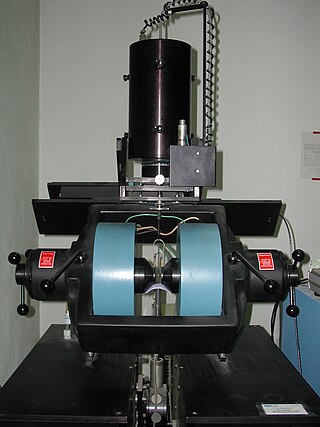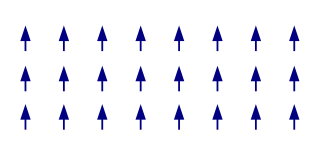Temperature dependence
To a first order approximation, the temperature dependence of spontaneous magnetization at low temperatures is given by the Bloch T3/2 law: [1] : 708

where M(0) is the spontaneous magnetization at absolute zero. The decrease in spontaneous magnetization at higher temperatures is caused by the increasing excitation of spin waves. In a particle description, the spin waves correspond to magnons, which are the massless Goldstone bosons corresponding to the broken symmetry. This is exactly true for an isotropic magnet.
Magnetic anisotropy, that is the existence of an easy direction along which the moments align spontaneously in the crystal, corresponds however to "massive" magnons. This is a way of saying that they cost a minimum amount of energy to excite, hence they are very unlikely to be excited as  . Hence the magnetization of an anisotropic magnet is harder to destroy at low temperature and the temperature dependence of the magnetization deviates accordingly from the Bloch T3/2 law. All real magnets are anisotropic to some extent.
. Hence the magnetization of an anisotropic magnet is harder to destroy at low temperature and the temperature dependence of the magnetization deviates accordingly from the Bloch T3/2 law. All real magnets are anisotropic to some extent.
Near the Curie temperature,

where β is a critical exponent that depends on the universality class of the magnetic interaction. Experimentally the exponent is 0.34 for iron and 0.51 for nickel. [2]
An empirical interpolation of the two regimes is given by

it is easy to check two limits of this interpolation that follow laws similar to the Bloch law, for  , and the critical behavior, for
, and the critical behavior, for  , respectively.
, respectively.

Ferromagnetism is a property of certain materials that results in a significant, observable magnetic permeability, and in many cases, a significant magnetic coercivity, allowing the material to form a permanent magnet. Ferromagnetic materials are familiar metals that are noticeably attracted to a magnet, a consequence of their substantial magnetic permeability. Magnetic permeability describes the induced magnetization of a material due to the presence of an external magnetic field. This temporarily induced magnetization, for example, inside a steel plate, accounts for its attraction to the permanent magnet. Whether or not that steel plate acquires a permanent magnetization itself depends not only on the strength of the applied field but on the so-called coercivity of the ferromagnetic material, which can vary greatly.

Magnetism is the class of physical attributes that occur through a magnetic field, which allows objects to attract or repel each other. Because both electric currents and magnetic moments of elementary particles give rise to a magnetic field, magnetism is one of two aspects of electromagnetism.

Paramagnetism is a form of magnetism whereby some materials are weakly attracted by an externally applied magnetic field, and form internal, induced magnetic fields in the direction of the applied magnetic field. In contrast with this behavior, diamagnetic materials are repelled by magnetic fields and form induced magnetic fields in the direction opposite to that of the applied magnetic field. Paramagnetic materials include most chemical elements and some compounds; they have a relative magnetic permeability slightly greater than 1 and hence are attracted to magnetic fields. The magnetic moment induced by the applied field is linear in the field strength and rather weak. It typically requires a sensitive analytical balance to detect the effect and modern measurements on paramagnetic materials are often conducted with a SQUID magnetometer.

In condensed matter physics, a spin glass is a magnetic state characterized by randomness, besides cooperative behavior in freezing of spins at a temperature called 'freezing temperature' Tf. In ferromagnetic solids, component atoms' magnetic spins all align in the same direction. Spin glass when contrasted with a ferromagnet is defined as "disordered" magnetic state in which spins are aligned randomly or without a regular pattern and the couplings too are random.

In physics and materials science, the Curie temperature (TC), or Curie point, is the temperature above which certain materials lose their permanent magnetic properties, which can (in most cases) be replaced by induced magnetism. The Curie temperature is named after Pierre Curie, who showed that magnetism was lost at a critical temperature.

A ferrimagnetic material is a material that has populations of atoms with opposing magnetic moments, as in antiferromagnetism, but these moments are unequal in magnitude so a spontaneous magnetization remains. This can for example occur when the populations consist of different atoms or ions (such as Fe2+ and Fe3+).

Spontaneous symmetry breaking is a spontaneous process of symmetry breaking, by which a physical system in a symmetric state spontaneously ends up in an asymmetric state. In particular, it can describe systems where the equations of motion or the Lagrangian obey symmetries, but the lowest-energy vacuum solutions do not exhibit that same symmetry. When the system goes to one of those vacuum solutions, the symmetry is broken for perturbations around that vacuum even though the entire Lagrangian retains that symmetry.
In physics, a ferromagnetic material is said to have magnetocrystalline anisotropy if it takes more energy to magnetize it in certain directions than in others. These directions are usually related to the principal axes of its crystal lattice. It is a special case of magnetic anisotropy. In other words, the excess energy required to magnetize a specimen in a particular direction over that required to magnetize it along the easy direction is called crystalline anisotropy energy.
In particle and condensed matter physics, Goldstone bosons or Nambu–Goldstone bosons (NGBs) are bosons that appear necessarily in models exhibiting spontaneous breakdown of continuous symmetries. They were discovered by Yoichiro Nambu in particle physics within the context of the BCS superconductivity mechanism, and subsequently elucidated by Jeffrey Goldstone, and systematically generalized in the context of quantum field theory. In condensed matter physics such bosons are quasiparticles and are known as Anderson–Bogoliubov modes.
The classical XY model is a lattice model of statistical mechanics. In general, the XY model can be seen as a specialization of Stanley's n-vector model for n = 2.

A magnon is a quasiparticle, a collective excitation of the spin structure of an electron in a crystal lattice. In the equivalent wave picture of quantum mechanics, a magnon can be viewed as a quantized spin wave. Magnons carry a fixed amount of energy and lattice momentum, and are spin-1, indicating they obey boson behavior.

Rock magnetism is the study of the magnetic properties of rocks, sediments and soils. The field arose out of the need in paleomagnetism to understand how rocks record the Earth's magnetic field. This remanence is carried by minerals, particularly certain strongly magnetic minerals like magnetite. An understanding of remanence helps paleomagnetists to develop methods for measuring the ancient magnetic field and correct for effects like sediment compaction and metamorphism. Rock magnetic methods are used to get a more detailed picture of the source of the distinctive striped pattern in marine magnetic anomalies that provides important information on plate tectonics. They are also used to interpret terrestrial magnetic anomalies in magnetic surveys as well as the strong crustal magnetism on Mars.
In magnetism, the Curie–Weiss law is a mean-field theory that describes the magnetic susceptibility χ of a ferromagnet in the paramagnetic region above the Curie point:
In condensed matter physics, a spin wave is a propagating disturbance in the ordering of a magnetic material. These low-lying collective excitations occur in magnetic lattices with continuous symmetry. From the equivalent quasiparticle point of view, spin waves are known as magnons, which are bosonic modes of the spin lattice that correspond roughly to the phonon excitations of the nuclear lattice. As temperature is increased, the thermal excitation of spin waves reduces a ferromagnet's spontaneous magnetization. The energies of spin waves are typically only μeV in keeping with typical Curie points at room temperature and below.
In quantum field theory and statistical mechanics, the Mermin–Wagner theorem states that continuous symmetries cannot be spontaneously broken at finite temperature in systems with sufficiently short-range interactions in dimensions d ≤ 2. Intuitively, this means that long-range fluctuations can be created with little energy cost, and since they increase the entropy, they are favored.
In condensed matter physics, magnetic anisotropy describes how an object's magnetic properties can be different depending on direction. In the simplest case, there is no preferential direction for an object's magnetic moment. It will respond to an applied magnetic field in the same way, regardless of which direction the field is applied. This is known as magnetic isotropy. In contrast, magnetically anisotropic materials will be easier or harder to magnetize depending on which way the object is rotated.

The term magnetic structure of a material pertains to the ordered arrangement of magnetic spins, typically within an ordered crystallographic lattice. Its study is a branch of solid-state physics.

In condensed matter physics, an Arrott plot is a plot of the square of the magnetization of a substance, against the ratio of the applied magnetic field to magnetization at one fixed temperature(s). Arrott plots are an easy way of determining the presence of ferromagnetic order in a material. They are named after American physicist Anthony Arrott who introduced them as a technique for studying magnetism in 1957.
In condensed matter physics, the quantum dimer magnet state is one in which quantum spins in a magnetic structure entangle to form a singlet state. These entangled spins act as bosons and their excited states (triplons) can undergo Bose-Einstein condensation (BEC). The quantum dimer system was originally proposed by Matsubara and Matsuda as a mapping of the lattice Bose gas to the quantum antiferromagnet. Quantum dimer magnets are often confused as valence bond solids; however, a valence bond solid requires the breaking of translational symmetry and the dimerizing of spins. In contrast, quantum dimer magnets exist in crystal structures where the translational symmetry is inherently broken. There are two types of quantum dimer models: the XXZ model and the weakly-coupled dimer model. The main difference is the regime in which BEC can occur. For the XXZ model, the BEC occurs upon cooling without a magnetic field and manifests itself as a symmetric dome in the field versus temperature phase diagram centered about H = 0. The weakly-coupled dimer model does not magnetically order in zero magnetic field, but instead orders upon the closing of the spin gap, where the BEC regime begins and is a dome centered at non-zero field.
Magnetic 2D materials or magnetic van der Waals materials are two-dimensional materials that display ordered magnetic properties such as antiferromagnetism or ferromagnetism. After the discovery of graphene in 2004, the family of 2D materials has grown rapidly. There have since been reports of several related materials, all except for magnetic materials. But since 2016 there have been numerous reports of 2D magnetic materials that can be exfoliated with ease just like graphene.















